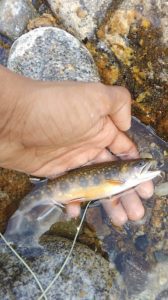After the recent cold spell, I threw in the towel for my fly fishing season. Although at times I like winter fly fishing, iced-up guides, cold feet, and subzero temperatures aren’t my cup of tea. Plus, I couldn’t ignore the pinhole leak in my right leg any more. So, in the comfort of my living room, I will share some lessons I have learned this season.
Explore Further: Humans are creatures of habit. We tend to fish the same rivers and stick to a few familiar runs and pools. This is why many popular rivers such as the Upper Connecticut have named pools. There is absolutely nothing wrong with fishing these areas. They have many fish, large fish, and unique history. However, there is something special about finding your own secret spots. Many refer to these spots as “in-between areas” and are overlooked for that reason.
That is a mistake.
Fish that sit in this shallower water do so to actively feed. I routinely catch more fish in these sections than anywhere else on the river. Faster water also makes fish more opportunistic and less spooky, which brings me to my next lesson.


Approach Better: There is a nice run at the Isinglass River. A cascade comes in at the head and creates two seams. The far seam is deeper and faster than the close seam. The close seam is only 18″ to 24″ deep and is fairly narrow. Automatically, you assume that the fish will be at the other end. You wade in and fish the other end. You catch a couple fish, but spook other easily catch-able fish.
In many rivers, you may get away with doing this since recently-stocked fish are used to people. However, in rivers with wild or holdover trout, messy wading can spook the entire run. Next time, take a second. Observe, plan, and cast before wading in.
Fish Headwaters: Explore small streams. The fish are small, but opportunistic. Headwaters are good places to learn new techniques or hone a skill. Plus, the small scale approach you take will help you break down larger water with ease.

Fish Tailwaters: Tailwaters provide stable environments for trout. Bottom release dams keep the water cold in the summer and warm in the winter. Hatches are plentiful year round, but trout can feed selectively at times. I used to hate tailwaters due to the high fishing pressure and selective fish.
However, my views have since changed due to their healthy populations of large, wild fish. As with any other river, there is room to trek off the beaten path. For hardcore fly anglers, there is no better option for year-round fishing.

Happy Holidays to all!
Discover more from BlogFlyFish.com
Subscribe to get the latest posts sent to your email.

A great post, Ashu. So much of what you mentioned really resonates with me. I can get “stuck in a rut” and need to branch out more.
I’m the ultimate creature of habit. That’s why my buddy Tom calls me bagpipe, Bags is always at the pipe on the Swift. Learning to read water has been a challenge for me but steelheading is definitely helping me learn quick.
Haha!
Thanks Jo! Haha bagpipe, love it!